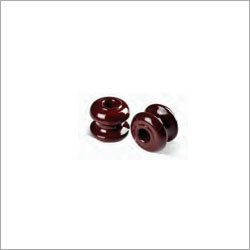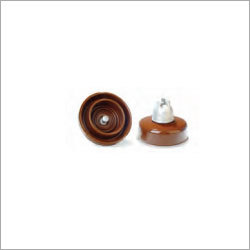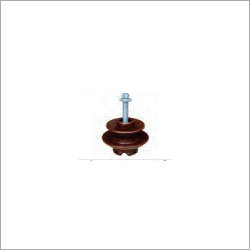
Shackle Insulator
3500 INR/Unit
Product Details:
X
Shackle Insulator Price and Quantity
- 100 Unit
- 3500 INR/Unit
Shackle Insulator Trade Information
- 100 Unit Per Week
- 1 Week
Product Description
Shackle Insulator is currently employed as strain insulators, but it is only used in a small percentage of voltage distribution lines. This can be employed either vertically or horizontally. It is bolted to the pole unless a cross arm is used. This insulator is a low-voltage insulator that is used in distribution networks. This product is another name for this insulator. It can be used in either horizontal or vertical settings. This serves as a barrier between energised elements of an electric circuit, limiting current flow to wires or other conducting routes.
Uses of Shackle Insulator:
1. Overhead Transmission Lines: Shackle insulators are widely used in overhead transmission lines to support and insulate the conductors from the transmission towers. They help maintain a safe distance between the energized conductors and the grounded tower structure, preventing electrical leakage and minimizing the risk of electrical faults.
2. Distribution Lines: Shackle insulators are used in distribution lines to support power lines between utility poles. They help in maintaining proper clearance between the conductors and the poles, preventing power loss due to short circuits or electrical arcing.
3. Substation Equipment: Shackle insulators are employed in substations to support various equipment such as circuit breakers, disconnect switches, and lightning arresters. They provide electrical insulation between the equipment and the ground or the supporting structures, ensuring safe operation and reducing the risk of electrical faults.
4. Guy Wires: In some cases, shackle insulators are used in guy wires that provide stability to utility poles or towers. The insulators prevent the flow of electricity from the conductor to the ground through the guy wires, reducing the potential for grounding faults.
5. Railway Electrification: Shackle insulators are also used in electrified railway systems. They help to insulate the overhead catenary wires that supply power to the trains, preventing interference with the ground and ensuring safe and reliable train operation.
6. Telecommunication Cables: In certain cases, shackle insulators are used to support and insulate telecommunication cables, such as fiber optic cables, from the supporting structures. This prevents electrical interference that could disrupt communication signals.
7. High-Voltage Equipment Testing: Shackle insulators are used in high-voltage testing setups to provide support and insulation for high-voltage equipment undergoing testing. They help isolate the equipment under test from the ground and surrounding structures, ensuring accurate testing results and safety for the operators.
8. Outdoor Lighting: Shackle insulators can be used in outdoor lighting systems to support and insulate lighting fixtures, ensuring that electrical current is properly directed through the lighting elements while minimizing the risk of short circuits or grounding faults.
Advantages of Shackle Insulator:
1. Electrical Insulation: Shackle insulators are designed to provide high levels of electrical insulation. They prevent the flow of electricity from the energized conductor to the supporting structure or ground, minimizing the risk of electrical leakage, short circuits, and electrical faults.
2. High Voltage Handling: Shackle insulators are capable of handling high voltages, making them suitable for use in high-voltage transmission and distribution systems. They help maintain the necessary insulation levels even under challenging voltage conditions.
3. Mechanical Strength: Shackle insulators are built to withstand mechanical stresses such as tension, compression, and vibration that occur due to wind, ice, and other environmental factors. Their sturdy construction ensures that they can support the weight of conductors and other equipment without failure.
4. Durability: Shackle insulators are typically made from materials like porcelain, glass, or composite materials, which are known for their durability and resistance to environmental factors such as UV radiation, moisture, and temperature fluctuations. This longevity reduces the need for frequent replacements, leading to cost savings over time.
5. Low Maintenance: Due to their durability and resistance to environmental factors, shackle insulators require minimal maintenance. This is especially advantageous in remote or hard-to-access locations where regular maintenance may be challenging.
6. Corrosion Resistance: Shackle insulators are often designed to resist corrosion caused by environmental factors, such as rain, humidity, and chemical pollutants. This feature ensures the insulators maintain their performance over extended periods.
7. Easy Installation: Shackle insulators are relatively easy to install on transmission towers, utility poles, and other supporting structures. Their design allows for straightforward attachment to conductors and connection points.
8. Variety of Designs: Shackle insulators come in various designs and sizes to accommodate different conductor sizes, voltage levels, and application requirements. This versatility allows for customization based on the specific needs of the power system.
9. Cost-Effectiveness: Shackle insulators offer a cost-effective solution for electrical insulation and support in power systems. Their durable construction and low maintenance requirements contribute to reduced operating costs over the insulators' lifespan.
10. Safety: By preventing electrical leakage and short circuits, shackle insulators contribute to the safety of both the power system equipment and personnel. They help reduce the risk of electrical accidents and outages.
11. Compatibility with Accessories: Shackle insulators can often be used in conjunction with various accessories such as clamps, connectors, and hardware. This enhances their flexibility and compatibility with different system configurations.
FAQ:
1. What is a shackle insulator?
Ans: A shackle insulator, also known as a pin insulator, is an electrical component used to support and insulate power conductors from the structures they are mounted on, preventing electrical leakage and ensuring safe transmission of electricity.
2. What materials are shackle insulators made from?
Ans: Shackle insulators are commonly made from materials like porcelain, glass, or composite materials. These materials provide the necessary electrical insulation, mechanical strength, and durability required for their applications.
3. Where are shackle insulators used?
Ans: Shackle insulators are primarily used in overhead transmission and distribution lines, substations, railway electrification systems, and other applications that require electrical insulation and support.
4. How do shackle insulators provide electrical insulation?
Ans: Shackle insulators are designed with a non-conductive material that prevents the flow of electricity from the conductor to the supporting structure. This insulation helps avoid electrical leakage and potential short circuits.
5. What are the advantages of shackle insulators?
Ans: Some advantages of shackle insulators include electrical insulation, high voltage handling capability, mechanical strength, durability, low maintenance, corrosion resistance, and ease of installation.
6. How do shackle insulators handle mechanical stresses?
Ans: Shackle insulators are constructed to withstand mechanical stresses caused by tension, compression, wind, ice, and other environmental factors. Their design ensures they can support the weight of conductors and equipment without failing.
7. Can shackle insulators handle high voltages?
Ans: Yes, shackle insulators are designed to handle high voltages in transmission and distribution systems. They maintain their electrical insulation properties even under high-voltage conditions.
8. Are there different sizes of shackle insulators available?
Ans: Yes, shackle insulators come in various designs and sizes to accommodate different conductor sizes, voltage levels, and application requirements.
9. Do shackle insulators require maintenance?
Ans: Shackle insulators typically require minimal maintenance due to their durability and resistance to environmental factors. Regular visual inspections may be necessary to identify any damage or wear.
10. Can shackle insulators be used in different applications apart from power systems?
Ans: Yes, shackle insulators can also be used in applications such as railway electrification, telecommunications, outdoor lighting, and high-voltage equipment testing setups, where electrical insulation and support are essential.
11. How are shackle insulators installed?
Ans: Shackle insulators are attached to the conductors using appropriate clamps and connectors. They are then mounted on supporting structures such as transmission towers or utility poles.
12. Are there safety considerations when using shackle insulators?
Ans: Using shackle insulators helps enhance safety in power systems by preventing electrical accidents and outages. However, proper installation, maintenance, and adherence to safety protocols are still necessary to ensure overall system safety.
13. Can shackle insulators resist environmental factors?
Ans: Yes, shackle insulators are designed to resist environmental factors such as UV radiation, moisture, temperature fluctuations, and chemical pollutants, which ensures their longevity and performance.
14. Can shackle insulators be used with other accessories?
Ans: Yes, shackle insulators can often be used in combination with various accessories like clamps, connectors, and hardware to facilitate their installation and enhance compatibility with different system configurations.
15. Are there regulations governing the use of shackle insulators?
Ans: Yes, the use of shackle insulators in power systems is subject to electrical safety regulations and standards set by relevant authorities and organizations in the field of electrical engineering.
Enter Buying Requirement Details
 English
English Spanish
Spanish French
French German
German Italian
Italian Chinese (Simplified)
Chinese (Simplified) Japanese
Japanese Korean
Korean Arabic
Arabic Portuguese
Portuguese


